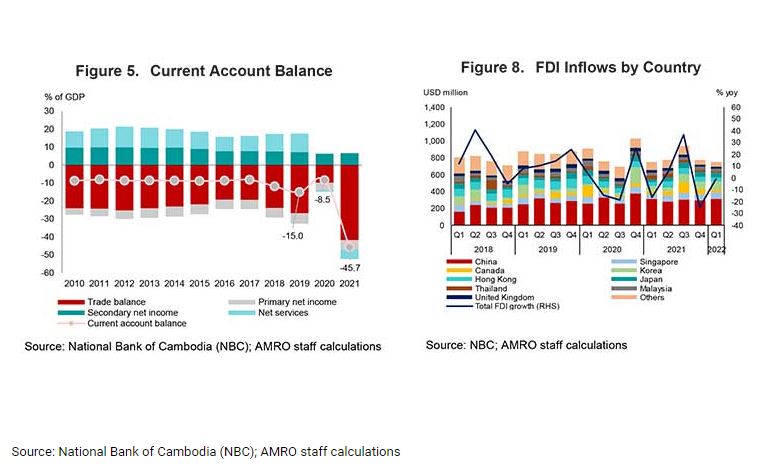Cambodia: Kingdom’s current account deficit likely to improve
Amid a significant pickup in the trade and economy in Cambodia, the current account deficit, which is more imports and less of exports, is expected to improve, but it may remain high in 2022 at 35.1 percent of the gross domestic product (GDP), says the AMRO’s 2022 Annual Consultation Report on Cambodia.
For 2022, exports grew rapidly by 37.7 percent in the first half, driven by garment exports. This slowed to 18.3 percent in July and abruptly dropped to 1.5 percent in August and is expected to remain sluggish for the rest of the year as the global economy slows down.
Though in the first half of the current year exports registered rapid growth of 37.7 percent on the back of good performance of the garment sector, the outward shipment declined to 18.3 percent in July. After that, the decline continued with growth being just 1.5 percent in August.
Given the global economic slowdown due to the lingering effect of the Covid-19 pandemic and an almost year-long conflict between Russia and Ukraine that has disrupted the supply chain across the world, shipment from the country is expected to remain sluggish for the rest of the year, says the ASEAN+3 Macroeconomic Research Office (AMRO) report released on Tuesday.
During the year, inbound shipments also increased across all major products led by petroleum, textile, and construction materials. Of this, the import of gold remained substantial at $4.2 billion in the eight months (January-August) of the year.
A current account deficit means that the country is importing more goods and services than it is exporting. It also includes net income (such as interest and dividends) and transfers from abroad (such as foreign aid), which are usually a small fraction of the total.
The report is based on AMRO’s annual consultation visit led by its Deputy Group Head and Senior Economist Jinho Choi to the Kingdom of Cambodia between July 20 and August 3, 2022, as well as data and information available up to September 15.
“The high imports, due in large part to elevated global prices of oil and other commodities, has resulted in a large trade deficit equivalent to 25 percent of GDP during the first eight months of 2022, albeit lower than the 27.1 percent deficit in the same period last year,” the AMRO report read.
For the whole year 2022, export is still seen to grow by double-digits, mostly due to the excellent performance in the first half of the year. However, “the current account deficit (excluding gold) is expected to remain high at 21.9 percent of GDP in 2022 (or 35.1 percent including gold),” it said.
The inflow of foreign direct investment (FDI) has remained stable at $801 million in the first quarter of the current year. The FDI inflows from China stayed consistent and resilient despite Beijing’s zero-Covid-19 policy. The other major sources of the FDI included Canada, the United Kingdom, South Korea, and Japan among others, and ASEAN (Association of Southeast Asian Nations) peers like Thailand, Singapore, and Malaysia.
Though foreign exchange reserves were $19.5 billion as of June 2022, they remained sufficient to meet the 9.3 months of imports of goods (excluding gold) and services, stated the AMRO report.
Source: https://www.khmertimeskh.com/501207271/kingdoms-current-account-deficit-likely-to-improve/


 English
English




